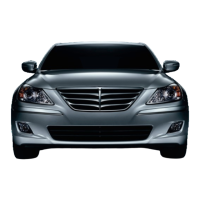Do you have a question about the Hyundai GENESIS 2013 and is the answer not in the manual?
Illustrates and labels key components in the engine compartment for both 2.0L TCI and 3.8L GDI engines.
Describes driver's, front passenger's, and rear seats, including adjustment features and headrests.
Explains the seat belt restraint system, precautions, care, and warnings for proper use.
Details the importance of rear seat placement, specific requirements, and proper installation of child seats.
Covers the operation, components, warning lights, and precautions related to the vehicle's air bag system.
Identifies gauges and indicators on the instrument cluster for 2.0L and 3.8L engines, including warning lights.
Details controls for temperature, mode selection, fan speed, air conditioning, and defrost functions.
Explains system operation for ventilation, heating, and defrosting using AUTO and manual controls.
Describes how to use Bluetooth® for hands-free calling, voice recognition, and audio streaming.
Provides step-by-step instructions for starting the engine, including manual and automatic transmissions, and cold weather procedures.
Explains the operation of the illuminated engine start/stop button and the steering lock system.
Details manual transmission operation, including shift patterns, downshifting, and cautions for engagement.
Describes automatic transmission operation, gear ranges, sports mode, and shift lock system.
Explains how to set, increase, decrease, temporarily accelerate, cancel, and turn off the cruise control system.
Provides immediate actions for engine stalls in traffic or flat tires, emphasizing safety and gradual deceleration.
Guides on how to safely handle a flat tire by releasing the accelerator, braking gently, and moving off the road.
Instructs on what to do if the engine stalls, including reducing speed, using hazard flashers, and seeking assistance.
Covers checks for engines that won't turn over or start normally, including fuel level and battery connections.
Provides critical safety procedures for jump-starting a vehicle, warning against incorrect connections and battery hazards.
Details the step-by-step process for connecting jumper cables safely and correctly to start a vehicle.
Advises against push-starting vehicles with automatic transmissions due to potential damage.
Outlines steps to take if the engine overheats, including stopping safely, checking coolant, and seeking professional help.
Explains the TPMS malfunction and low tire pressure indicators, emphasizing proper tire maintenance.
Covers necessary tools and jacking instructions for changing a flat tire, emphasizing safety precautions.
Details the process of changing a tire, including parking safely, activating hazard lights, and shifting the transmission.
Provides guidance on acceptable towing methods, including using dollies or flatbeds, and warnings against improper towing.
Recommends using authorized HYUNDAI dealers or commercial services for emergency towing and proper procedures.
Offers instructions for emergency towing using a cable or chain, emphasizing extreme caution and specific procedures.
Illustrates and labels key components in the engine compartment for both 2.0L TCI and 3.8L GDI engines.
Stresses the importance of proper servicing, recommending authorized HYUNDAI dealers for all work.
Lists vehicle checks and inspections recommended for owners to ensure safe and dependable operation.
Outlines maintenance intervals for normal and severe usage conditions, including mileage and time recommendations.
Explains specific maintenance items, including engine oil, drive belts, fuel filter, and vapor hoses.
Details how to check engine oil level, warnings about hot components, and recommended oil types.
Covers checking coolant level, recommended mixtures, warnings about hot coolant, and engine damage from improper coolant.
Explains how to check brake fluid level, use of specified fluid, and warnings regarding contact with eyes or paint.
Provides instructions for filter replacement and cleaning, emphasizing the use of genuine parts.
Details filter inspection and replacement procedures, with cautions to avoid damaging components.
Offers advice for best battery service, warnings about battery dangers, and proper disposal of batteries.
Covers tire care, recommended cold inflation pressures, and warnings about tire underinflation and overinflation.
Illustrates and labels key components in the engine compartment for both 2.0L TCI and 3.8L GDI engines.
Describes driver's, front passenger's, and rear seats, including adjustment features and headrests.
Explains the seat belt restraint system, precautions, care, and warnings for proper use.
Details the importance of rear seat placement, specific requirements, and proper installation of child seats.
Covers the operation, components, warning lights, and precautions related to the vehicle's air bag system.
Identifies gauges and indicators on the instrument cluster for 2.0L and 3.8L engines, including warning lights.
Details controls for temperature, mode selection, fan speed, air conditioning, and defrost functions.
Explains system operation for ventilation, heating, and defrosting using AUTO and manual controls.
Describes how to use Bluetooth® for hands-free calling, voice recognition, and audio streaming.
Provides step-by-step instructions for starting the engine, including manual and automatic transmissions, and cold weather procedures.
Explains the operation of the illuminated engine start/stop button and the steering lock system.
Details manual transmission operation, including shift patterns, downshifting, and cautions for engagement.
Describes automatic transmission operation, gear ranges, sports mode, and shift lock system.
Explains how to set, increase, decrease, temporarily accelerate, cancel, and turn off the cruise control system.
Provides immediate actions for engine stalls in traffic or flat tires, emphasizing safety and gradual deceleration.
Guides on how to safely handle a flat tire by releasing the accelerator, braking gently, and moving off the road.
Instructs on what to do if the engine stalls, including reducing speed, using hazard flashers, and seeking assistance.
Covers checks for engines that won't turn over or start normally, including fuel level and battery connections.
Provides critical safety procedures for jump-starting a vehicle, warning against incorrect connections and battery hazards.
Details the step-by-step process for connecting jumper cables safely and correctly to start a vehicle.
Advises against push-starting vehicles with automatic transmissions due to potential damage.
Outlines steps to take if the engine overheats, including stopping safely, checking coolant, and seeking professional help.
Explains the TPMS malfunction and low tire pressure indicators, emphasizing proper tire maintenance.
Covers necessary tools and jacking instructions for changing a flat tire, emphasizing safety precautions.
Details the process of changing a tire, including parking safely, activating hazard lights, and shifting the transmission.
Provides guidance on acceptable towing methods, including using dollies or flatbeds, and warnings against improper towing.
Recommends using authorized HYUNDAI dealers or commercial services for emergency towing and proper procedures.
Offers instructions for emergency towing using a cable or chain, emphasizing extreme caution and specific procedures.
Illustrates and labels key components in the engine compartment for both 2.0L TCI and 3.8L GDI engines.
Stresses the importance of proper servicing, recommending authorized HYUNDAI dealers for all work.
Lists vehicle checks and inspections recommended for owners to ensure safe and dependable operation.
Outlines maintenance intervals for normal and severe usage conditions, including mileage and time recommendations.
Explains specific maintenance items, including engine oil, drive belts, fuel filter, and vapor hoses.
Details how to check engine oil level, warnings about hot components, and recommended oil types.
Covers checking coolant level, recommended mixtures, warnings about hot coolant, and engine damage from improper coolant.
Explains how to check brake fluid level, use of specified fluid, and warnings regarding contact with eyes or paint.
Provides instructions for filter replacement and cleaning, emphasizing the use of genuine parts.
Details filter inspection and replacement procedures, with cautions to avoid damaging components.
Offers advice for best battery service, warnings about battery dangers, and proper disposal of batteries.
Covers tire care, recommended cold inflation pressures, and warnings about tire underinflation and overinflation.
| Brand | Hyundai |
|---|---|
| Model | GENESIS 2013 |
| Category | Automobile |
| Language | English |












